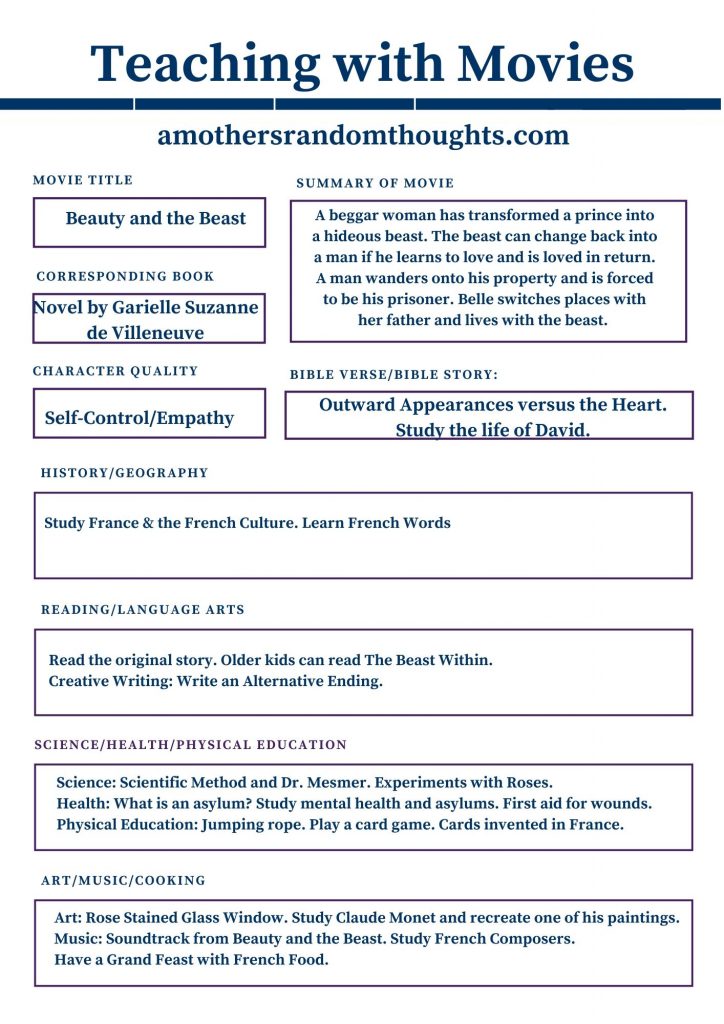Let’s face it, as much as we try to get some of our children to love reading, there are just some kids that will never enjoy it. We are all wired differently, but that doesn’t mean that our children cannot still envelop the love of learning. For my youngest son, watching movies and spring boarding that into a learning experience seems to be the best way to teach him. When I quit trying to fit a square peg in a round hole, he began to learn more and more. That is when I adopted teaching with dinner and a movie.
“If they can’t learn the way we teach, we teach the way they learn.”
O. Ivar Lovass
One of the important things to remember when teaching is that you are only there to facilitate the learning experience. Your child is the one doing the learning, and if you can find a creative way for them to love it, you have not only won a battle, but you have won the entire war. (I only wish that I would have figured out my second’s child learning style before it turned into a war).

STEPS TO TEACHING WITH DINNER AND A MOVIE:
- We usually select a movie for the entire week (or two depending on how in-depth we want to get with that movie). To start, select a movie that your child loves. This helps to get them really interested in this type of learning. See if there are other versions you can watch to compare and contrast.
- Check to see if there is already a book that the movie is based on. Over on my site, I have done some research for a host of movies. I have already done some of the work for you over on my blog. Sometimes, you will not find a book, but you may be able to find books that are similar to the theme of the movie. For example, the movie Ratatouille is not based on a book, but you can teach about famous chefs.

- Compare the book to the movie.
- As you research the movie, fill in the following form. This will help you to outline the movie in “subjects.”
- Begin with Bible and Character Development, because I have learned that if you teach nothing else all year, this will take your children further than anything else will. As you look at the movie – I use Beauty and the Beast as an example – God talks of outward appearance versus the heart. 1 Samuel 16:7 “But the Lord said to Samuel, “Do not look at his appearance or on the height of his stature, because I have rejected him. For the Lord sees not as man sees: man looks on the outward appearance, but the Lord looks on the heart.” The character quality I chose for Beauty and the Beast was self-control. The Beast needs to learn how to control his temper.
- Geography/History: Beauty and the Beast is based on a French novel written by Gabrielle-Suzanne de Villeneuve in 1740. We studied France and it’s current culture, but you can dive in and study France of the 1700s.
- Reading/Language Arts – Read a version of the original Beauty and the Beast. Even if your child is older, picture books are fascinating to get from the library and study. There are so many versions of Beauty and the Beast are each person has illustrated it differently. This is a study in and of itself. Do not get hung up on the idea that “picture books are for young children.” Additionally, there are teen retellings.
- Creative Writing: Write an alternative ending to the story such as Belle ends up married to Gaston. For younger children, have them tell you a story and write it out.
- Science: Experiment with roses – How long can a rose last in different conditions?
- Health: Study asylums. Gaston was going to commit Maurice to an asylum. Compare our modern-day mental health facilities to institutions of old.
- Art: Make invitations to invite people to your dinner and movie. Create napkin rings. Select dinner music. Consider classical music from French artists in the 1700s.
- Base your dinner selections on either food found in the movie or a traditional French dinner (French Onion Soup, Nicoise Salad, Beef Stew, Asparagus, Potatoes Au Gratin, Chocolate Mousse or the Gray Stuff, Fruit Tarts, Sparkling Juice or Wine).
- Dress-up, set the table to reflect the culture or time period (example: for a Japanese dinner sit on the floor on oversized pillows), and enjoy your dinner with the final showing of the movie!
Your children will remember the movies surrounding their dinners, and they will remember the time spent learning and playing.
—oOo—

Thank you Patty Moliterno @ A Mother’s Random Thoughts for sharing with us today.
